In 2017, DJI introduced the Spark. With a palm-sized body, gesture control and a sub-$500 price point, the system was firmly targeted at social media. It was, in essence, a selfie-drone.
The little quadcopter built up a fanbase, though apparently not one large enough to justify its own continued existence. DJI quietly discontinued the device in 2019, replacing it with the Mavic Mini, the smallest member of its wildly popular folding consumer drone line.
This week at IFA in Berlin, DJI is once again going small with the new Neo. Like the Spark before it, the drone’s ability to land in the palm of the user’s hand is a major selling point. Among other things, that’s shorthand for Neo’s small footprint: At 135 grams (0.3 pound), DJI says its the “most compact and lightest” drone it has produced.
Indeed, it’s significantly lighter than both the Spark (300 grams) and Mavic Mini (249 grams). Of course, a small footprint comes with its share of drawbacks, chief among them battery life. The system has a listed flight time of 18 minutes on a charge, which limits what one can do with the drone.
This isn’t designed to replace the Mavic Mini outright. For one thing, the Mini 4 came out just a few months back. Another major selling point, along with the ability to land on one’s palm, is remote-free control. That puts the system squarely in the social media/influencer camp that DJI was targeting with Spark. Another one in that camp: Snap’s Pixy, which died its own fiery death earlier this year.
It remains to be seen just how large of a potential market we’re talking about here. Hover offers the most compelling palm drone to date. DJI taking another swing at the category is validation in its own right. The Shenzhen-based firm effectively owns the drone market at this point.
Like Hover’s drones, DJI has opted to completely cage in Neo’s blades. That’s a good thing for what is being positioned as a beginner drone. When the Spark launched, our video producer managed to slice her finger on the blade. For that to happen here, you really have to be trying.
Much of the system’s navigation relies on subject tracking and other AI functionality. DJI outlines the following shooting modes:
It’s worth noting that the Neo will launch with limited availability. The drone is up for pre-sale in the U.S. starting today, but no word yet on a ship date. It runs $199 in a base configuration and $289 when bundled with three extra batteries.
Source @TechCrunch



